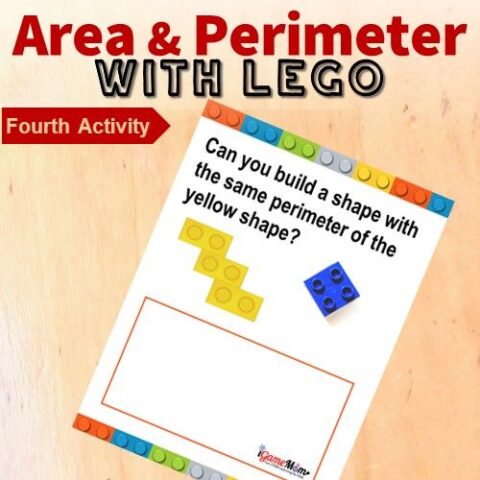What to do with old LEGO bricks? Start a LEGO building challenge and learn math concepts and higher level thinking. This LEGO Challenge Game is for elementary kids who are learning basic geometry, and help them reinforce the concepts of area and perimeter. What is more, all the challenges not only reinforce math and geometry concepts, but also encourage higher level thinking skills. Students need some logic thinking and problem solving skills for these fun LEGO challenges on area and perimeter.

What LEGO bricks are needed for this LEGO challenge game?
Most basic LEGO bricks, such as 1×1, 1×2, 2×4. Try find different sizes and different color bricks. But no special shapes are needed.
Math concepts this LEGO game reinforces
Area and perimeter are two important math concepts.
Area is the total surface a shape covers.
Perimeter is a measurement of the distance around a shape.
RELATED: Geometry Game Puzzle Testing Visual Perception Skills – Free Download
Skills gained via this LEGO Math Challenge Game
Besides math concepts of area and perimeter, students also learn problem solving via spacial reasoning and logic analysis. When using appropriate sized LEGO bricks, kids may also practice fine motor skills trying to line up the bricks into certain shapes.
How to play LEGO Math Challenge Game for Area and Perimeter
First, download the LEGO Math Challenge Game for Area and Perimeter package. You can also find it on TeachersPayTeachers: LEGO Challenge Game for Area and Perimeter on TpT.
Inside the package, you will find 5 different games, each starts with easy builds and progressively gets harder: 1. Compare two shapes to decide which one has a bigger area; 2. Build a shape that is the required area size; 3. Compare two shapes to decide which one has a longer perimeter; 4. Build a shape of the required perimeter; 5. Bonus Game: more like a brain teaser. Move a piece of LEGO brick to match a given area or perimeter.
Here are details of each game:
1. Compare two shapes and pick the one with a bigger area:
Kids are given two shapes built with simple LEGO bricks. They need to compare the two shapes and decide which one has a bigger area. The games start with very simple shapes, such as regular rectangles built with two 2×2 bricks and three 1×2 shapes. Gradually, the shapes get more complicated that can be an irregular shape. Kids need fully understand the concept, and be able to break a big irregular shape into several smaller regular shapes to get the area of the shape.
There are different ways to get the areas of the shapes:
First, it is to build the shapes with real LEGO bricks. Then lay the bricks from one shape on top of the other to see which is bigger.
Two, it is to use the area formula to calculate the area of each shape and then compare the results between the two shapes.

2. Build a shape of a certain area with LEGO bricks
Kids are given a shape and then are asked to build a shape that is a size of certain multiples or fractions of the given shape, like twice or one-third of the area of the given shape.
It starts again from simple regular shapes, then gets hard with irregular shapes. This game reinforces kids’ understanding of the area concept from a different angle.
For younger children, you can ask them to count out the number of the 1×1 units in each shape, then decide how many 1×1 units they need for the new shape. They can then pick the right LEGO bricks to build a shape to meet the criteria.

>>> Download LEGO Area & Perimeter Challenge Game <<<
3. Compare two shapes and pick the one with a longer perimeter:
As with area games, this game also starts with simple regular shapes that are easy to build with regular LEGO bricks.
Different from the area, the perimeter is not as straightforward when comparing between two shapes, as it is not proportional to the area. For example, a 2×1 LEGO brick has a perimeter of 6, while a 2×2 LEGO brick’s perimeter is 8.
When first switching from area games to perimeter games, kids may struggle with it due to the non-proportional nature of the perimeter game. For struggling kids, teachers can guide them to count the units along the edge of each shape to decide on the perimeter of each shape, write down the number for each shape, and then compare the two numbers.

4. Build a shape of a certain perimeter:
Kids are given a shape and then asked to build a shape of a certain size with a perimeter in relation to the given shape, for example, 4 times longer perimeter of the given shape, or one-third of the perimeter of the given shape.
Similar to the last challenge game, kids may be confused between area and perimeter at first, as perimeter size is not visually intuitive as area size. This is a good time to re-explain the difference between area and perimeter and help kids build an intuitive sense of each concept.

5. Bonus Challenges
These additional games are for kids who have fully grasped the concepts of area and perimeter and like to have more mental challenges in solving harder problems. They are mental twists for kids all ages.

>>> Download LEGO Area & Perimeter Challenge Game <<<
>> On TeachersPayTeachers: LEGO Area & Perimeter Challenge Game <<
For more geometry challenges, check out
Geometry Challenges Improving Spatial Reasoning Skills
For more LEGO Math Games, check out
LEGO Superhero Area and Perimeter Game with a free game board
LEGO Math Game for Coordinate Plane with Free Download
LEGO Build Proof of Pythagorean Theorem with free template








This is such an interesting idea for making math fun for kids. It can help them to learn and understand various math concepts. Thanks for sharing!